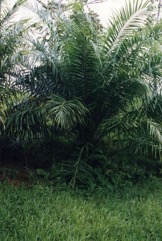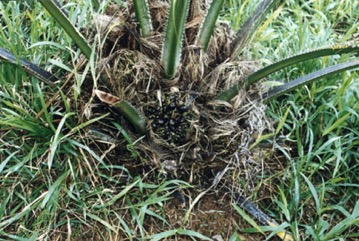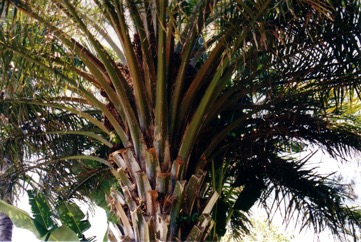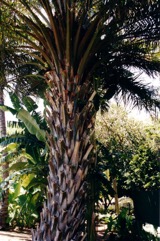African Oil palm

A tropical plant. They need a temperature above 18°C. They suit the hot humid tropics. They grow between 16°N and 15°S in Africa. These palms do well in rich moist soil. A rainfall above 2,000 mm is needed for good production. They need a sunny position. They are drought and frost tender. It grows from sea level to 900 m above sea level. It grows in areas with a mean annual temperature between 27-35°C. It grows in areas with a mean annual rainfall between 2,000-3,000 mm. Plantations are established in West New Britain in Papua New Guinea and palms occur in some other areas of the country. In Cairns Botanical Gardens. It suits hardiness zones 10-12. In Yunnan.
Also known as:
Abura yashi, Aobara, Apwuraiasi, Asomme, Atchichi, Ba di ngasi, Ba di nsamba, Balia, Be yiya, Bemintchi, Caiauke, Corojo de Guinea, Dendes, Doung breng, Earra, Ekpe, Igi okpe, Ikye, Isa, Ivile, Kanjindo, Kepala sawit, Kibila, Kikasi, Kwakwa, Lara, Libala, Loombo, Macaw-fat, Mchikichi, Mintchame, Mjenga, Mubira, Munazi, Mupomu, Ngazi, Nkula, N'queme, Nsamba, Oil palm, Palma africana, Palmeir de oleo, Palmeira de azeite, Palmeira dendem, Palmera, Palmier-a-huile, Quem, Ribe, Sihtan, Si-ohn, Tem-em-eih, Tem-o, Toun, Tsingilo, Tugueih, You zong
Synonyms
- Elaeis melanococca Gaertn.
- Elaeis madagascariensis (Jum. & H. Perrier) Becc.
- and others
Edible Portion
- Seeds, Nuts, Cabbage, Fruit, Palm heart, Sap, Vegetable, Seeds - oil
Where does African Oil palm grow?
Found in: Africa, Amazon, Andamans, Angola, Asia, Australia, Benin, Bougainville, Brazil, Burkina Faso, Cambodia, Cameroon, Central Africa, Central African Republic, CAR, Central America, Chad, China, Colombia, Congo DR, Congo R, Costa Rica, Côte d'Ivoire, Cuba, Dominican Republic, East Africa, East Timor, Ecuador, FSM, Fiji, Gambia, Ghana, Guiana, Guianas, Guinea, Guinée, Guinea-Bissau, Guyana, Honduras, India, Indochina, Indonesia, Ivory Coast, Kenya, Liberia, Madagascar, Malawi, Malaysia, Mali, Mexico, Mozambique, Myanmar, Nicaragua, Nicaragua, Niger, Nigeria, Pacific, Papua New Guinea, PNG, Peru, Philippines, Pohnpei, Sao Tome and Principe, SE Asia, Senegal, Seychelles, Sierra Leone, Singapore, Solomon Islands, Southern Africa, South America, Sri Lanka, Sudan, Suriname, Tanzania, Timor-Leste, Togo, Uganda, Venezuela, West Africa, West Indies, Zambia
Notes: There are 2 Elaeis species.
Status: A major cash crop but also significant as a food by farmers in many areas.
Growing African Oil palm
Cultivation: They are normally grown from seed in a nursery then transplanted. Because seeds germinate slowly they are treated before planting. The seed are soaked for 7 days then sown into warm ground. Seeds are slow to germinate. Heat treatment is often used to ensure even germination. Seed germinate in 2-5 months under hot conditions. Seed are sown in plastic bags and sometimes a second nursery transplant is used before eventually planting in the field 1.5 to 2 years later. For heat treatment they are heated to about 40°C for for 10-12 weeks and then soaked in cold water for 3 days changing the water each day. They are then dried and allowed to germinate in shade. Plants are usually spaced at 9 m spacing.
Edible Uses: The outer layer of the fruits yields an orange cooking oil. The kernel also produces oil. The palm cabbage is edible. The sap tapped from the male flower is used to make wine. The oily fruit are sometimes eaten but can cause nausea. The leaves are burnt and used as a vegetable salt.
Production: The early growth of seedlings is slow. Palms commence bearing after about 4-6 years. When mature they produce 2-6 bunches per year. The flower bud does not develop until about 9 months after the leaf containing it has opened. Bright sunny weather helps the development of female flowers. Male flowers are more common in wet cloudy weather. Fruit matures 5-9 months after flowering. A bunch can weigh 18-25 kg. Palms live for many years. Individual trees can live for 200 years.
Nutrition Info
per 100g edible portion| Edible Part | Energy (kcal) | Protein (g) | Iron (mg) | Vitamin A (ug) | Vitamin c (mg) | Zinc (mg) | % Water |
|---|---|---|---|---|---|---|---|
| Seed | 538 | 1.6 | 4 | 18 | 9 | - | 28 |
| Seed dried | 587 | 6.6 | - | - | - | - | 11.5 |
African Oil palm Photos




References
Alyegba, S. S. et al, 2013, Ethnobotanical Survey of Edible Wild Plants in Tiv Communities of Benue State, Nigeria. Journal of Natural Sciences Research. Vol.3, No.7
Ambasta, S.P. (Ed.), 2000, The Useful Plants of India. CSIR India. p 191
Aniama, S. O., et al, 2016, Ethnobotanical documentaton of some plants among Igala people of Kogi State (Nigeria). The International Journal Of Engineering And Science (IJES). 5(4) pp 33-42
Ataga, C.D. & van der Vossen, H.A.M., 2007. Elaeis guineensis Jacq. [Internet] Record from Protabase. van der Vossen, H.A.M. & Mkamilo, G.S. (Editors). PROTA (Plant Resources of Tropical Africa), Wageningen, Netherlands. < http://database.prota.org/search.htm>. Accessed 15 October 2009.
Balick, M.J. and Beck, H.T., (Ed.), 1990, Useful palms of the World. A Synoptic Bibliography. Colombia p 301 (As Elaeis melanococca), 395 (As Elaeis melanococca),
Belem, M., et al, 2017, Strategy of Conservation and Protection of Wild Edible Plants Diversity in Burkina Faso. ANADOLU 27 (2) 2017, 82- 90
Bernholt, H. et al, 2009, Plant species richness and diversity in urban and peri-urban gardens of Niamey, Niger. Agroforestry Systems 77:159-179
Bodkin, F., 1991, Encyclopedia Botanica. Cornstalk publishing, p 376
Bremness, L., 1994, Herbs. Collins Eyewitness Handbooks. Harper Collins. p 53
Brickell, C. (Ed.), 1999, The Royal Horticultural Society A-Z Encyclopedia of Garden Plants. Convent Garden Books. p 393
Brouk, B., 1975, Plants Consumed by Man. Academic Press, London. p 235
Burkill, H. M., 1985, The useful plants of west tropical Africa, Vol. 4. Kew.
Burkill, I.H., 1966, A Dictionary of the Economic Products of the Malay Peninsula. Ministry of Agriculture and Cooperatives, Kuala Lumpur, Malaysia. Vol 1 (A-H) p 908
Catarino, L., et al, 2016, Ecological data in support of an analysis of Guinea-Bissau's medicinal flora. Data in Brief 7 (2016):1078-1097
Chai, P. P. K. (Ed), et al, 2000, A checklist of Flora, Fauna, Food and Medicinal Plants. Lanjak Entimau Wildlife Sanctuary, Sarawak. Forestry Malaysia & ITTO. p 163
Chapman, J. D. & Chapman, H. M., 2001, The Forest Flora of Taraba and Andamawa States, Nigeria. WWF & University of Canterbury. p 211
Cobley, L.S. (rev. Steele, W.M.) 2nd Ed., 1976, An Introduction to the Botany of Tropical Crops. Longmans. p 312
Coe, F. G., and Anderson, G. J., 1996, Ethnobotany of the Garifuna of Eastern Nicaragua. Economic Botany 50(1) pp 71-107
Coe, F. G. and Anderson, G. J., 1999, Ethnobotany of the Sumu (Ulwa) of Southeastern Nicaragua and Comparisons with Miskitu Plant Lore. Economic Botany Vol. 53. No. 4. pp. 363-386
Cundall, P., (ed.), 2004, Gardening Australia: flora: the gardener's bible. ABC Books. p 532
Dale, I. R. and Greenway, P. J., 1961, Kenya Trees and Shrubs. Nairobi. p 11
Danforth, R.M., & Boren, P.D., 1997, Congo Native fruits. Twenty-five of the best. Privately published. p 28
Dharani, N., 2002, Field Guide to common Trees & Shrubs of East Africa. Struik. p 288
Dibong, S. D., et al, 2011, Inventory and Biodiversity of species edible wild fruits sold in the markets of Douala, Cameroon. International Journal of Applied Biology and Pharmaceutical Technology. 2(3).
Djihounouck, Y., et al, 2018, Diversité Et Importance Socio-Economique Des Espèces Fruitières Sauvages Comestibles En Zone Kasa (Sud-Ouest Du Sénégal). European Scientific Journal December 2018 edition Vol.14, No.36 ISSN: 1857 – 7881
Etherington, K., & Imwold, D., (Eds), 2001, Botanica's Trees & Shrubs. The illustrated A-Z of over 8500 trees and shrubs. Random House, Australia. p 276
Facciola, S., 1998, Cornucopia 2: a Source Book of Edible Plants. Kampong Publications, p 28
Focho, D. A., et al, 2009, Ethnobotanical survey of Trees in Fundong, Northwest Region, Cameroon. Journal of Ethnobiology and Ethnomedicine, 5:17
Fowler, D. G., 2007, Zambian Plants: Their Vernacular Names and Uses. Kew. p 64
French, B.R., 1986, Food Plants of Papua New Guinea, A Compendium. Asia Pacific Science Foundation p 342
French, B.R., 2010, Food Plants of Solomon Islands. A Compendium. Food Plants International Inc. p 280
Gibbons, M., 1993, Palms. Compact study Guide and Identifier. Sandstone. p 40
Gibbons, M., 2003, A pocket guide to Palms. Chartwell Books. p 103
Grubben, G. J. H. and Denton, O. A. (eds), 2004, Plant Resources of Tropical Africa 2. Vegetables. PROTA, Wageningen, Netherlands. p 561
Hahn, K., et al, 2018, The Use of Wild Plants for Food: a National Scale Analysis for Burkina Faso (West Africa) Flora et Vegetatio Sudano-Sambesica 21, 25-33
Hardon, J.J., 1979, Oil palm, in Simmonds, N.W., (ed), Crop Plant Evolution. Longmans. London. p 225
Hawthorne, W.& Marshall, C., 2013, Nimba Western Area Iron Ore Concentrator Mining Project Environmental and Social Impact Assessment. AcelorMittel Liberia. p 476
Hedrick, U.P., 1919, (Ed.), Sturtevant's edible plants of the world. p 286
Heywood, V.H., Brummitt, R.K., Culham, A., and Seberg, O., 2007, Flowering Plant Families of the World. Royal Botanical Gardens, Kew. p 348
Hibbert, M., 2002, The Aussie Plant Finder 2002, Florilegium. p 91
Janick, J. & Paul, R. E. (Eds.), 2008, The Encyclopedia of Fruit & Nuts. CABI p 118
Jardin, C., 1970, List of Foods Used In Africa, FAO Nutrition Information Document Series No 2.p 33, 76
Johnson, D.V., 1998, Tropical palms. Non-wood Forest products 10. FAO Rome. p 131
Jones, D.L., 1994, Palms throughout the World. Smithtonian Institution, Washington. p 211
Jones, D.L., 2000, Palms of Australia 3rd edition. Reed/New Holland. p 156
Kalman, D. S., et al, 2013, Efficacy and safety of Elaeis guineensis and Ficus deltoidea leaf extracts in adults with pre-diabetes. Nutrition Journal, 12:36
Katende, A.B., Birnie, A & Tengnas B., 1995, Useful Trees and Shrubs for Uganda. Identification, Propagation and Management for Agricultural and Pastoral Communities. Technical handbook No 10. Regional Soil Conservation Unit, Nairobi, Kenya. p 260
Latham, P., 2004, Useful Plants of Bas-Congo province. Salvation Army & DFID p 119
Lautenschläger, T., et al, 2018, First large-scale ethnobotanical survey in the province of Uíge, northern Angola. Journal of Ethnobiology and Ethnomedicine (2018) 14:51
Lord, E.E., & Willis, J.H., 1999, Shrubs and Trees for Australian gardens. Lothian. p 96
Manvell, A., 2011, Use of Non-Timber Forest Products around Sapo National Park, Liberia (Report B) p 52
Marcia, M. J., et al, 2011, Palm Uses in Northwestern South America: A Quantitative Review. Bot. Rev. (2011) 77:462-570
Martin, F.W. & Ruberte, R.M., 1979, Edible Leaves of the Tropics. Antillian College Press, Mayaguez, Puerto Rico. p 210
Martin, F. W., et al, 1987, Perennial Edible Fruits of the Tropics. USDA Handbook 642 p 47
Menninger, E.A., 1977, Edible Nuts of the World. Horticultural Books. Florida p 133
Miguel, E., et al, 1989, A checklist of the cultivated plants of Cuba. Kulturpflanze 37. 1989, 211-357
N'Diaye, M., et al.,2003, Principle fruits of gathering consumed and marketed in Guinea. Fruits, Vol. 58: 99-116
Nkeoua, G. & Boundzanga, G. C., 1999, Donnees sur les produits forestieres non ligneux en Republique du Congo. FAO. p 26
Omawale, 1973, Guyana's edible plants. Guyana University, Georgetown p 59
Peters, C. R., O'Brien, E. M., and Drummond, R.B., 1992, Edible Wild plants of Sub-saharan Africa. Kew. p 37
Phon, P., 2000, Plants used in Cambodia. © Pauline Dy Phon, Phnom Penh, Cambodia. p 269
Purseglove, J.W., 1972, Tropical Crops. Monocotyledons. Longmans p 479
Riffle, R.L. & Craft, P., 2003, An Encyclopedia of Cultivated Palms. Timber Press. p 333
Schuler, S., (Ed.), 1977, Simon & Schuster's Guide to Trees. Simon & Schuster. No. 53
Segnon, A. C. & Achigan-Dako, E. G., 2014, Comparative analysis of diversity and utilization of edible plants in arid and semi-arid areas in Benin. Journal of Ethnobiology and Ethnomedicine 2014, 10:80
Segura, S. et al, 2018, The edible fruit species in Mexico. Genet Resour Crop Evol (2018) 65:1767–1793
Seidemann J., 2005, World Spice Plants. Economic Usage, Botany, Taxonomy. Springer. p 143
Select. stirp. amer. hist. 280, t. 172. 1763
Small, E., 2009, Top 100 Food Plants. The world's most important culinary crops. NRC Research Press. p 374
Sukarya, D. G., (Ed.) 2013, 3,500 Plant Species of the Botanic Gardens of Indonesia. LIPI p 777
Terashima, H., et al, 1992, Ethnobotany of the Lega in the Tropical Rainforest of Eastern Zaire (Congo): Part Two, Zone de Walikale, African Study Monographs, Suppl. 19:1-60
Terashima, H., & Ichikawa, M., 2003, A comparative ethnobotany of the Mbuti and Efe hunter-gatherers in the Ituri Forest, Democratic Republic of Congo. African Study Monographs, 24 (1, 2): 1-168, March 2003
Termote, C., et al, 2011, Eating from the wild: Turumbu, Mbole and Bali traditional knowledge of non-cultivated edible plants, District Tshopo, DRCongo, Gen Resourc Crop Evol. 58:585-618
Terra, G.J.A., 1973, Tropical Vegetables. Communication 54e Royal Tropical Institute, Amsterdam, p 45
Udo, E. S., et al, 2009, Life-form and Density of Valuable Non-timber Plants in Ukpom Community Forest, Akwa Ibom State, Nigeria. African Research Review 3(3) p 7
Vael, L., 2015, Ethnobotanical study of the plant use in the natural landscape of two mestizo communities in the Ucayali region of the Peruvian Amazon. Universiteit Gent.
van Roosmalen, M.G.M., 1985, Fruits of the Guianan Flora. Utrecht Univ. & Wageningen Univ. p 348
van Wyk, B., 2005, Food Plants of the World. An illustrated guide. Timber press. p 184
Vasquez, R. and Gentry, A. H., 1989, Use and Misuse of Forest-harvested Fruits in the Iquitos Area. Conservation Biology 3(4): 350f
Vickery, M.L. and Vickery, B., 1979, Plant Products of Tropical Africa, Macmillan. p 27
White, F., Dowsett-Lemaire, F. and Chapman, J. D., 2001, Evergreen Forest Flora of Malawi. Kew. p 102
Wickens, G.E., 1995, Edible Nuts. FAO Non-wood forest products. FAO, Rome. p165
Williams, C.N., Chew, W.Y., and Rajaratnam, J.A., 1989, Tree and Field Crops of the Wetter Regions of the Tropics. Longman, p 197
Williamson, J., 2005, Useful Plants of Malawi. 3rd. Edition. Mdadzi Book Trust. p 104
World Checklist of Useful Plant Species 2020. Royal Botanic Gardens, Kew
www.worldagroforestrycentre.org/treedb/
Xu, You-Kai, et al, 2004, Wild Vegetable Resources and Market Survey in Xishuangbanna, Southwest China. Economic Botany. 58(4): 647-667.
Zuchowski W., 2007, Tropical Plants of Costa Rica. A Zona Tropical Publication, Comstock Publishing. p 388